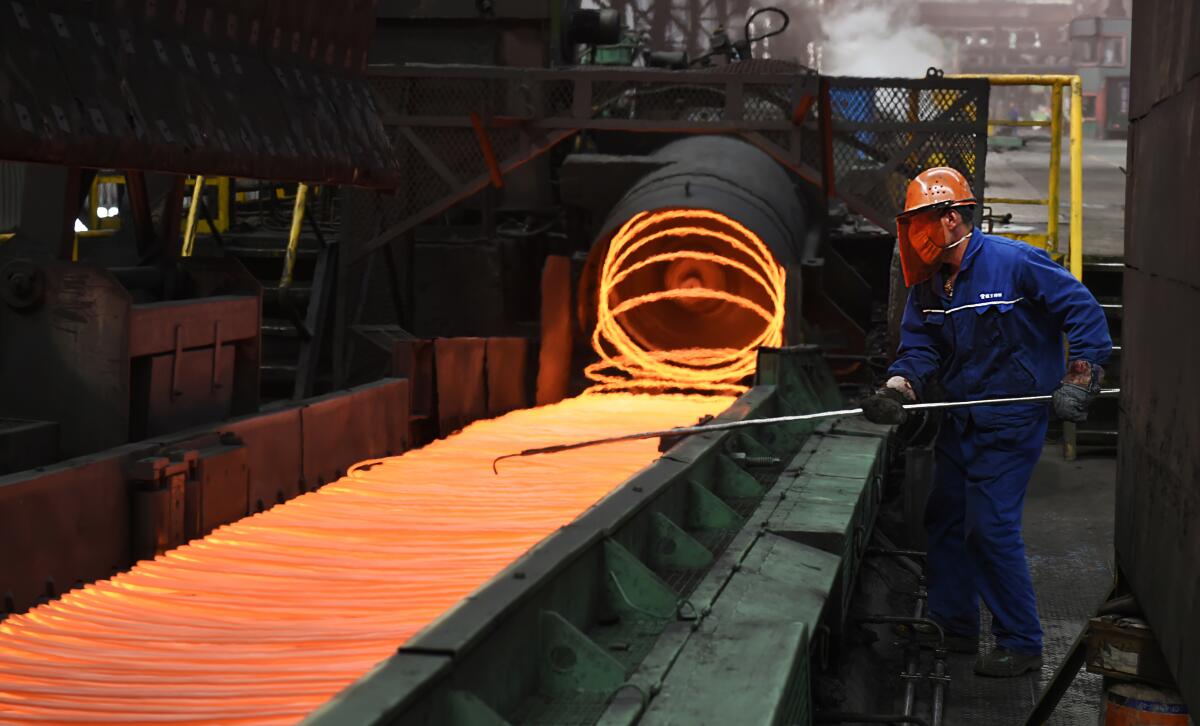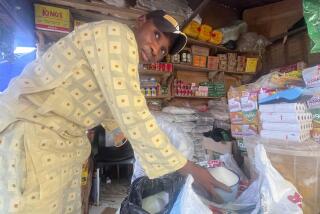The price of the stuff that makes everything is surging

- Share via
From steel and copper to corn and lumber, commodities started 2021 with a bang, surging to levels not seen for years. The rally threatens to raise the cost of goods from the lunchtime sandwich to gleaming skyscrapers.
It’s also lighted the fuse on the massive reflation trade that’s gripped markets this year and pushed up inflation expectations. With the U.S. economy pumped up on fiscal stimulus, and Europe’s economy starting to reopen as its vaccination rollout gets into gear, there’s little reason to expect a change in direction.
JPMorgan Chase & Co. said this week it sees a continued rally in commodities and that the “reflation and reopening trade will continue.” On top of that, the Federal Reserve and other central banks seem calm about inflation, meaning economies could be left to run hot, which will rev up demand even more.
“The most important drivers supporting commodity prices are the global economic recovery and acceleration in the reopening phase,” said Giovanni Staunovo, commodity analyst at UBS Group AG. The bank expects commodities as a whole to rise about 10% in the next year.
China, a crucial source of supply and demand for raw materials, is playing a big role, particularly as the government tries to reduce production of key metals such as steel and aluminum. It’s also buying up massive amounts of grains. Food prices are also being affected as poor weather in key growing nations such as Brazil and France hits harvests.
For countries, the impact of the commodity rally depends on whether they’re an exporter or importer. For those relying heavily on exporting raw materials, the huge upswings can only be good news for public finances, especially when they’ve just been stricken by a once-in-a-century pandemic. The likes of Australia (iron ore), Chile (copper) and Indonesia (palm oil) all make huge sums from commodities.
Meanwhile, countries looking to rebuild infrastructure may find their budgets buying less than they used to. President Biden’s $2.3-trillion plan is one such case. Electricity grids, railways and refurbishing buildings are among the items on the shopping list that will use large amounts of metal.
Consultancy CRU Group estimates the program will add 5 million tons of steel to the 80 million the U.S. uses each year, with similar boosts to aluminum and copper demand.
Steel producers in Europe and America have suffered for years from low prices caused by global overcapacity. Plants struggled to make money and job security became a growing worry. More than 85,000 steel jobs were lost in the European Union between 2008 and 2019, according to industry association Eurofer.
That’s all changed dramatically thanks to booming steel prices. Futures in China, by far the biggest producer, have smashed records — even outpacing gains in key ingredient iron ore — as the government took measures to curb output. That’s supercharged rallies of benchmark prices in Europe and America, where mills were already running at maximum capacity as they try to meet unexpectedly high demand.
Copper has enjoyed an unstoppable rally for more than a year thanks to pledges by governments to boost renewable energy and electric vehicle use. That’ll make all the various forms of green technology that rely on it a bit more expensive.
Bigger power grids is one such case. About 1.9 million tons of copper was used to build electricity networks in 2020, according to BloombergNEF, and the price of the red metal is up more than 90% in the last year. Usage will almost double by 2050, BNEF forecasts, while demand from other low-carbon technologies such as electric vehicles and solar panels will also balloon.
Food prices are also climbing. It’s been a tough year to be in the meat business, from devastating COVID-19 outbreaks to the deadly pig disease that hit Germany and is roaring back in China.
And as crop prices surge, farmers raising poultry, pigs and cattle are among the first to get squeezed by the eye-watering run-up in grains. Costs for corn fed to livestock have doubled in the last year, and soybean meal is more than 40% higher. While there’s a delay before that hits the burger chain or steakhouse, there are already signs of prices creeping higher.
Whether you prefer latte or espresso, sweetened or plain, the key ingredients of a cup of coffee have surged. Arabica coffee futures have risen about 33% in the last year, while raw sugar has also advanced. Fancy a slice of toast? Benchmark wheat prices have hit the highest since 2013.
Of course, rising commodities don’t immediately show up on grocery shelves and cafe menus. They make up just a part of the costs for retailers, which often absorb the initial increase to keep customers coming back. But there’s a limit to that margin hit, and high prices could ultimately feed through to consumers.
Bloomberg writers Jack Farchy, Manisha Jha and Liezel Hill contributed to this report.
More to Read
Inside the business of entertainment
The Wide Shot brings you news, analysis and insights on everything from streaming wars to production — and what it all means for the future.
You may occasionally receive promotional content from the Los Angeles Times.










